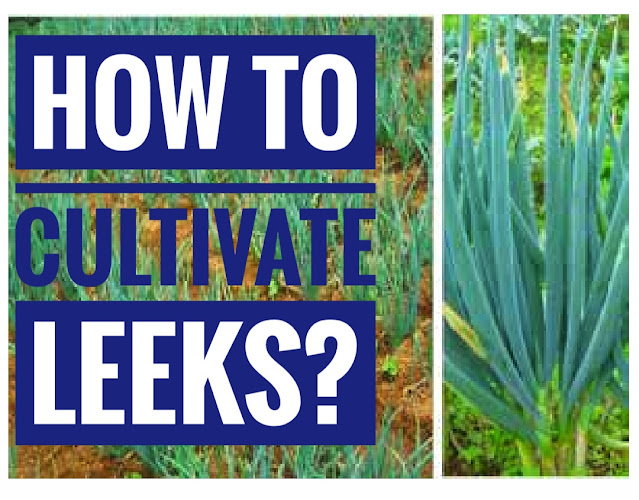Leek plant
There are 3 types of leeks that are often cultivated, namely:
- Leeks or leek (Allium porum L.), have no bulbs and have leaves that are wider than those of shallots or garlic, the midrib is long and tough and the inside of the leaf is flat.
- Chives (Allium schoercoprasum), have small, long leaves, small, green cavities in the leaves, and small bulbs.
- Onions leek or semprong onions (Allium fistulosum), long-leafed with cavities in the leaves like a pipe, sometimes bulbous.
Growing Requirements
Leek are suitable to grow, in the lowlands and highlands with an altitude of 250-1500 m above sea level, although in the lowlands there are not too many leeks. Areas with rainfall of 150-200 mm/year and daily temperature of 18-25°C are suitable for the growth of leeks. This plant requires a neutral pH (6.5-7.5) with Andosol soil (former volcanic land) or sandy loam soil.
Cultivation
1. Seeds
Onion seeds can come from seeds or from shoots (shoot cuttings). Saplings are obtained by separating healthy and well-growing saplings from their parents. Onion seeds derived from seeds have a disadvantage, namely the longer harvest time compared to seeds derived from tiller shoots.
2. Nursery
Seedlings from shoot cuttings can be planted directly in the field by first reducing the roots to reduce evaporation. Seeds from seeds must be sown before planting in the field. The seedling media is a mixture of manure and soil (1:1) that has been loosened. Seeds are spread evenly then covered with a thin layer of soil (with a thickness of 0.5-1 cm) and watered sufficiently. Seedlings are ready to be transferred to the field when they have 2-3 leaves.
3. Land Preparation and Planting
The land is hoeed to a depth of 30-40 cm and then manure is added. This is done because leeks require loose soil for growth.
Then prepare beds with a width of 1-1.2 m with a length according to land conditions. The trench between the beds was made with a depth of 30 cm and a width of 30 cm.
Making a trench is very necessary for smooth drainage because leeks do not like standing water. The spacing used is 20 cm x 25 cm, 25 cm x 25 cm or 20 cm x 30 cm.
Planting is done by making small planting holes and seedlings or saplings are planted in an upright position and backfilled with soil and watered.
4. Maintenance
Weeding of weeds can be done simultaneously with weeding to loosen the soil that may be experiencing compaction. In addition, it is necessary to stockpile at the base of the stem.
This step is needed to get a white color on the pseudo-stem of the leek. Quality leeks have pseudo white stems with a length of approximately 1/3 of the entire plant.
Pseudo-white stems taste better while green ones are tougher and therefore less desirable. Stockpiling of stems should be done gradually to avoid rotting of stems and leaves, especially when the plants are still young.
Watering should be done especially if the leek is planted in the dry season, while if it is planted in the rainy season, drainage must be considered properly so that there is no puddle of water in the land. Fertilization consists of manure which is given at the time of tillage at a dose of 10-15 tons/ha.
Another fertilizer needed is Urea fertilizer 200 kg/ha which is given 2 times, namely when the plant is 21 days old (half dose) and the rest when the plant is 42 days old. SP 36 and KCl fertilizers were also given twice as Urea fertilizer, with the first fertilization dose of SP 36 50 kg and KCl 50 kg, and the second fertilization was SP 36 50 kg and KCl 25 kg.
Fertilization is done by making a row of approximately 5 cm on the left and right of the stem, and sprinkling fertilizer on the array and backfilling it with soil.
5. Control
Plant Destruction Organisms (OPT) Pests that are commonly found in leek plantations include Agrotis sp. (causing the stems to cut and break so that the plant dies), Spodoptera exigua (onion caterpillars that eat leeks), and Thrips tabaci (sucking leaves).
Mechanical control of onion caterpillars can be done by collecting egg groups and destroying them. Control with pesticides must be carried out properly, both in choosing the type, dose, spray volume, application method, interval and time of application.
The disease that attacks leeks is Erwinia carotovora with symptoms of soft rot, wetness and an unpleasant odor, besides that, Alternaria porri (purple spot) attacks the leaves. Control of this disease can be done by crop rotation to break the disease life cycle and garden sanitation to prevent dampness.
Dirty and damp garden conditions cause disease to develop quickly.
6. Harvest and Postharvest
Onion plants can be harvested at the age of 2 months after planting The potential yield ranges from 7-15 tons/ha.
Harvesting is done by pulling all parts of the plant including roots, removing rotten or withered roots and leaves. If the leek will be replanted at the next planting, then the selection of healthy and good growth tiller shoots is carried out and then separated from the part of the plant to be sold.
Simple sorting is done by combining the clumps with large leaves separately with clumps with small leaves. The tying of the leek clump is done by first placing a base on the outside of the clump so that the bond does not directly hit the scallion clump.
Shallots (chives) cannot be stored for long, so they should be marketed immediately so that the quality is still maintained when it reaches consumers.

